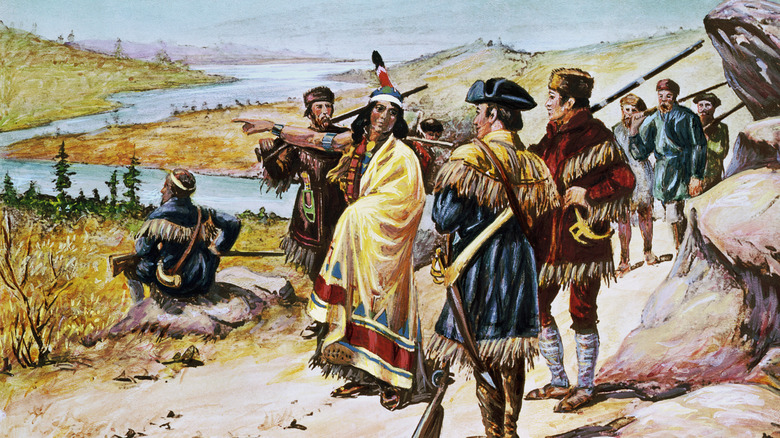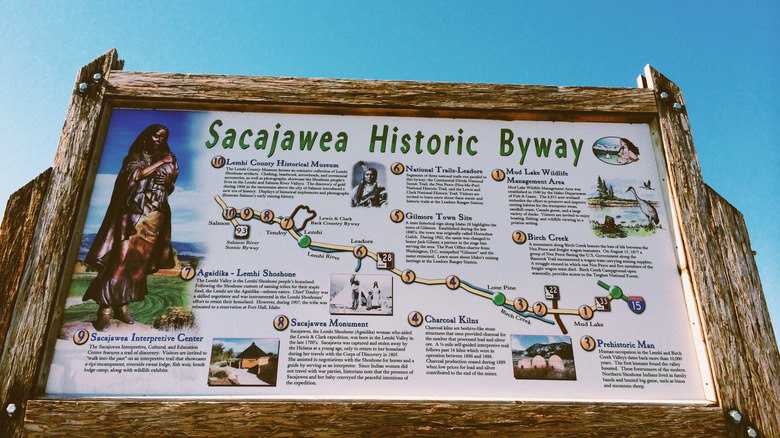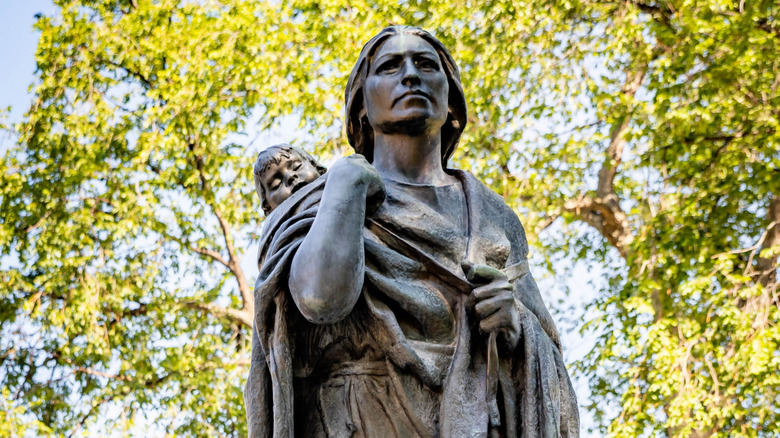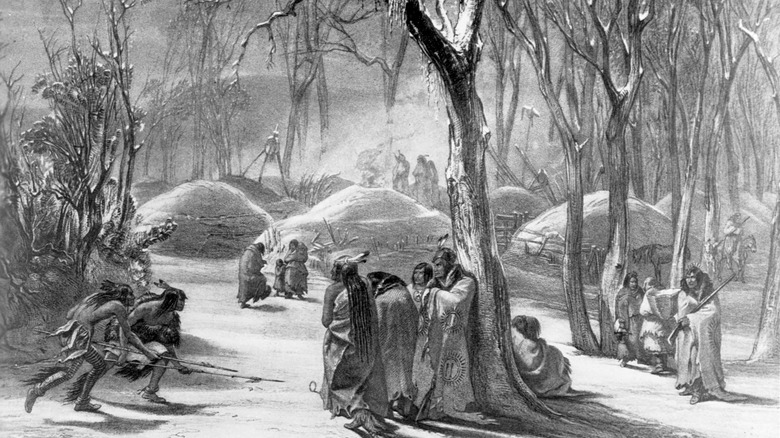The Biggest Thing Everyone Gets Wrong About Sacagawea
Among the important historical narratives of the United States that have become part of the country's mythos is the expedition that took place between 1804 and 1806 by Meriwether Lewis and William Clark. And at the center of this is the Native American woman Sacagawea (also written Sacajawea), who has been lionized for her role in helping in the 8,000 mile trek from what is now Missouri to the Pacific Ocean in Oregon and back.
She's been featured on a U.S. coin, and there are more Sacagawea statues honoring the indigenous woman than any other woman born on American soil. But what we actually know about Sacagawea is pretty limited. We don't even know how to properly spell or say her name (in the expedition journals it's spelled several ways). Still, perhaps the biggest mistake everyone gets wrong about Sacagawea may be the tribal nation she belonged to, at least based on new evidence. Traditionally, Sacagawea has been considered a Shoshone who had been kidnapped by the Hidatsa, but there's evidence to suggest that she was born a Hidatsa and was instead taken hostage by the Shoshone.
Sacagawea's role in the Lewis and Clark expedition
In 1803, President Thomas Jefferson initiated plans for what would be termed the Corps of Discovery. By the winter of 1804 to 1805, Meriwether Lewis, William Clark, and their more than 40 men had reached what is now present-day North Dakota, where they built a fort near some settled Mandan and Hidatsa villages on the Missouri River. It was here that they met a French Canadian fur trader named Toussaint Charbonneau and his teenage wife, Sacagawea. She was somewhere between 15 and 17 years old and pregnant when Charbonneau convinced Lewis and Clark to take them on the expedition west.
Before the long journey, she gave birth to a son, Jean Baptiste, who she brought with her, as she acted as an interpreter and guide. Sacagawea would show her worth to the explorers in several ways, including saving several valuable items such as instruments and papers after one of the Corp's boats nearly capsized in May 1805. What we know of Sacagawea comes via Lewis and Clark's journals and from what Charbonneau told them, but that's where things get a little iffy. Charbonneau didn't speak much English so anything he told the explorers was filtered through a translator. And that included the story of Sacagawea's alleged kidnapping by the Hidatsa.
The traditional version of Sacagawea's life
The traditional version of Sacagawea's heritage is that she was born a Shoshone and grew up in the Rocky Mountains in what is present day Idaho. The Hidatsa kidnapped her at age 12, and they later sold her to Toussaint Charbonneau. But like the questions surrounding Sacagawea's name – its spelling, pronunciation, and meaning — there are some mysteries as to her origins. All the information about her childhood came from Charbonneau. He was less than reliable as both his Hidatsa, the language he used with Sacagawea, and his English were paltry. In order to speak to Meriwether Lewis and William Clark, he had to go through a member of the Corps who spoke French and English.
During the expedition, the Corps visited the Shoshone and, according to the published journals, Sacagawea danced and celebrated when reunited with her people, including her brother. But that scene doesn't appear in the original notes of either Lewis or Clark. It only showed up in the official version that came out in 1814, nearly a decade after the expedition and five years after Lewis' death in 1809 under mysterious circumstances. Additionally, Lewis recorded in his journal that he couldn't detect any emotion from Sacagawea during the supposed homecoming. After the expedition, she returned to the Hidatsa village where Lewis and Clark first met her.
The Hidatsa's version of her life
The Hidatsa People tell a very different version of Sacagawea's life. In the book "Our Story of Eagle Woman, Sacagawea: They Got It Wrong," by the Sacagawea Project Board of the Mandan, Hidatsa & Arikara Nation, it describes Sacagawea as being born a Hidatsa who was known as Eagle Woman. In this version of events, based on oral history, it was the Shoshone who kidnapped her rather than the Hidatsa. She lived with her captors to the west until making her escape back to what is now North Dakota and her people. In a related story, her father took her to visit the Shoshone, where she became close with several of that nation's members.
In the Hidatsa version of her life, Sacagawea didn't die in 1812 of illness, which is the prevalent view, but rather survived into old age, dying at 82 in 1869 during a Sioux raid. Besides oral history, the book relies on DNA evidence linking her to living Hidatsa people to back its claims. Whatever the true story of Sacagawea's life, she has become a symbol of fortitude, motherhood, and unity, and an indelible part of the country's history.



